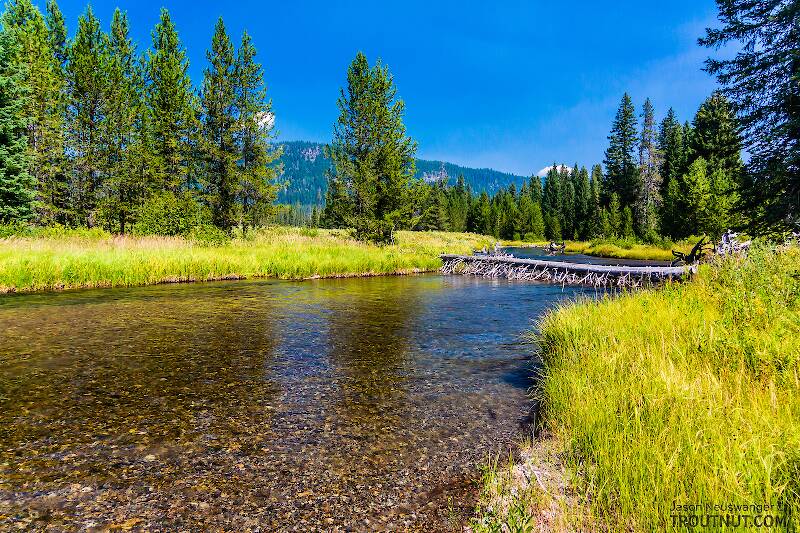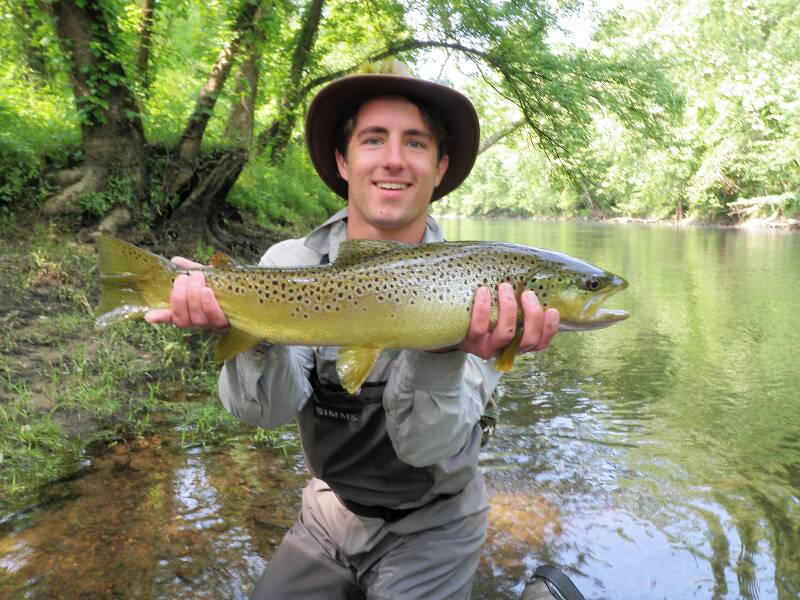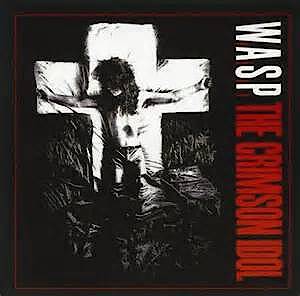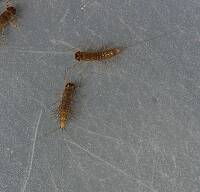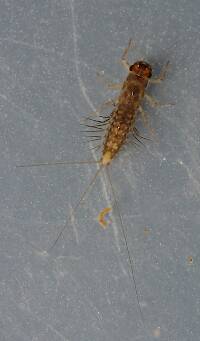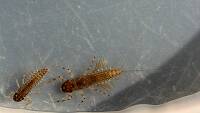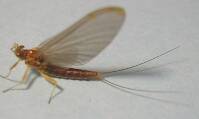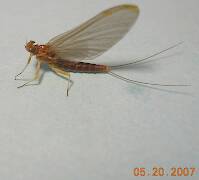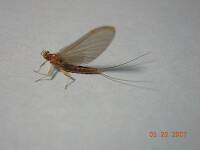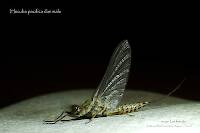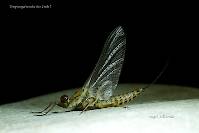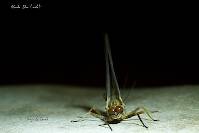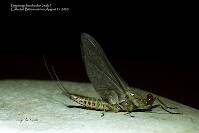
Salmonflies
Pteronarcys californica
The giant Salmonflies of the Western mountains are legendary for their proclivity to elicit consistent dry-fly action and ferocious strikes.
Featured on the forum

This one seems to tentatively key to Holocentropus, although I can't make out the anal spines in Couplet 7 of the Key to Genera of Polycentropodidae Larvae nor the dark bands in Couplet 4 of the Key to Genera of Polycentropodidae Larvae, making me wonder if I went wrong somewhere in keying it out. I don't see where that could have happened, though. It might also be that it's a very immature larva and doesn't possess all the identifying characteristics in the key yet. If Holocentropus is correct, then Holocentropus flavus and Holocentropus interruptus are the two likely possibilities based on range, but I was not able to find a description of their larvae.

Troutnut is a project started in 2003 by salmonid ecologist Jason "Troutnut" Neuswanger to help anglers and
fly tyers unabashedly embrace the entomological side of the sport. Learn more about Troutnut or
support the project for an enhanced experience here.
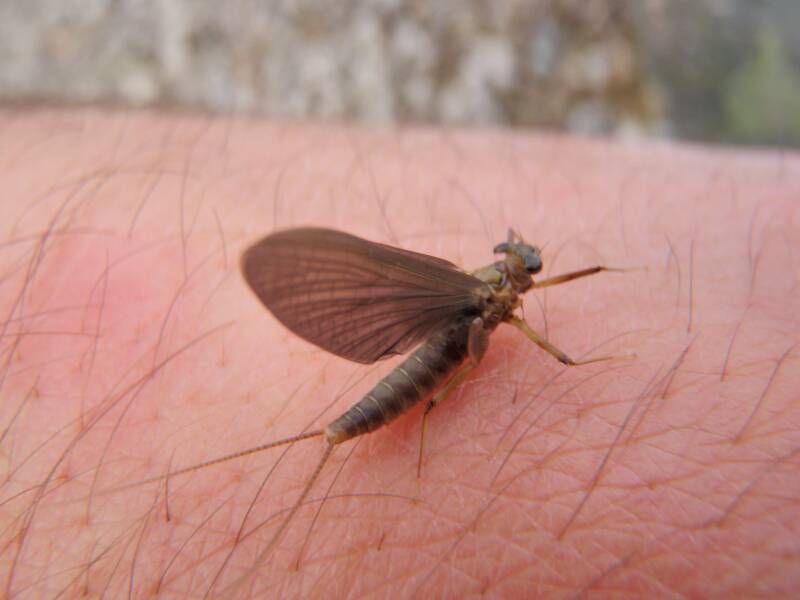
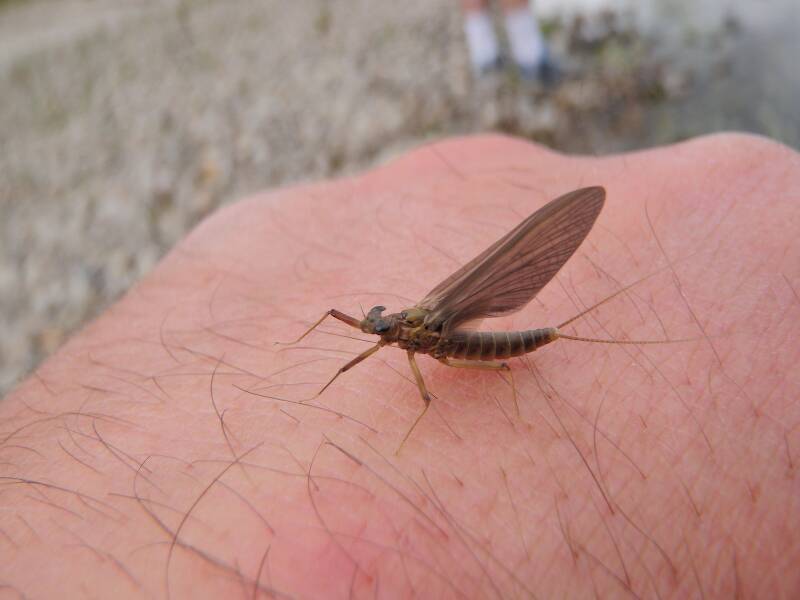
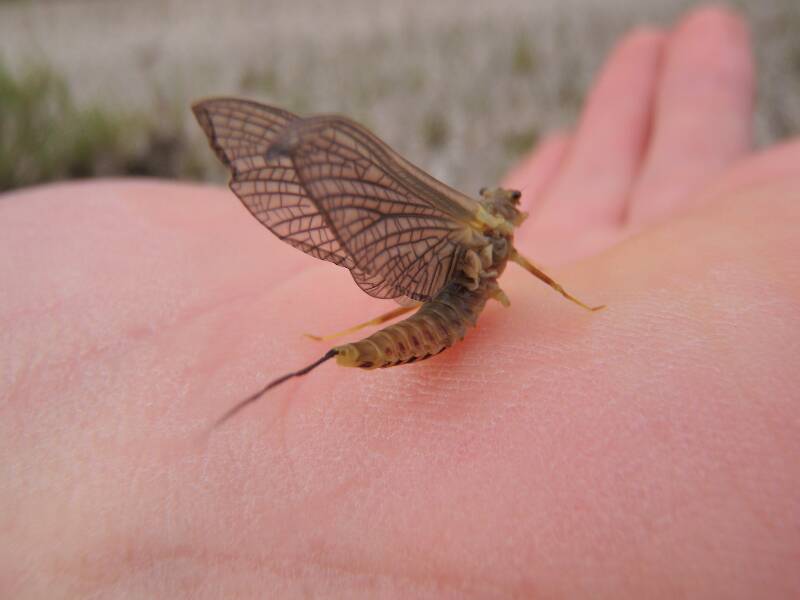
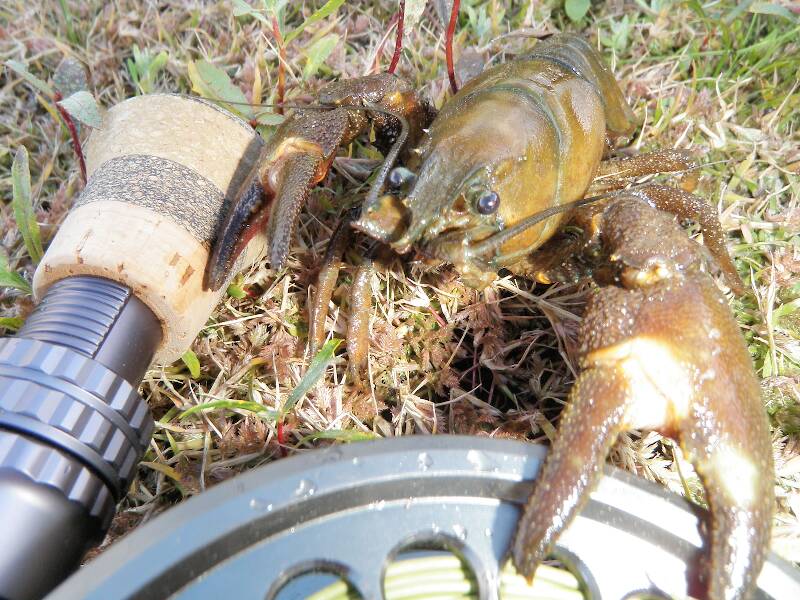
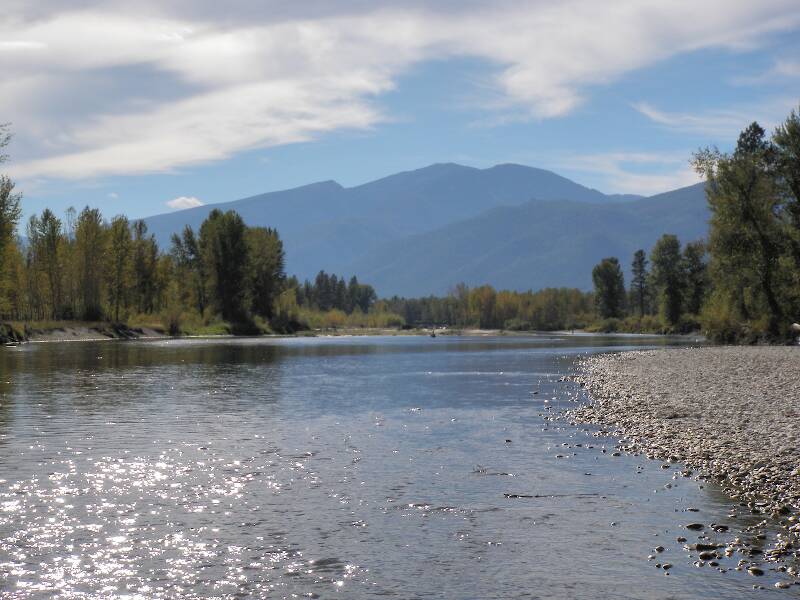
Jesse on Oct 3, 2010October 3rd, 2010, 3:55 am EDT
Just a few bugs to look at and a nice shot of the bitterroot!
Most of us fish our whole lives..not knowing its not the fish that we are after.
http://www.filingoflyfishing.com
http://www.filingoflyfishing.com
Aaron7_8 on Oct 3, 2010October 3rd, 2010, 5:57 am EDT
Not too many bad shots of the "Root" it is a truly beautiful place.
Jesse on Oct 3, 2010October 3rd, 2010, 5:54 pm EDT
Haha true true bud.
Most of us fish our whole lives..not knowing its not the fish that we are after.
http://www.filingoflyfishing.com
http://www.filingoflyfishing.com
Adirman on Oct 4, 2010October 4th, 2010, 1:36 am EDT
Nice pics of bugs, very clear. Are those BWO?
Jesse on Oct 4, 2010October 4th, 2010, 5:35 am EDT
Actually i believe, and someone correct me if im wrong but the first two shots are smaller mahoganys and the third is a hecuba. Pretty sure thats the right call bud.
Most of us fish our whole lives..not knowing its not the fish that we are after.
http://www.filingoflyfishing.com
http://www.filingoflyfishing.com
Taxon on Oct 4, 2010October 4th, 2010, 8:49 am EDT
Jesse-
Yes, I believe the first two mayfly photos are of Isonychia duns, and that the third mayfly photo is of a Timpanoga hecuba dun.
Yes, I believe the first two mayfly photos are of Isonychia duns, and that the third mayfly photo is of a Timpanoga hecuba dun.
GONZO on Oct 4, 2010October 4th, 2010, 2:22 pm EDT
Jesse and Roger,
I'm not sure what "mahogany" means on the Bitterroot, but I usually see that name associated with Western Paraleptophlebia hatches. The bugs in the first two photos look like heptageniids to me. Isonychia has larger hindwings with a different shape/venation (like that of siphlonurids).
I'm not sure what "mahogany" means on the Bitterroot, but I usually see that name associated with Western Paraleptophlebia hatches. The bugs in the first two photos look like heptageniids to me. Isonychia has larger hindwings with a different shape/venation (like that of siphlonurids).
PaulRoberts on Oct 4, 2010October 4th, 2010, 3:19 pm EDT
The first looks like a western "March Brown", a spring emerging Rhythrogena (not the eastern Maccaffertium vicarum -old Stenonema). I've heard of a "late March Brown" but I'm not sure who that is yet. Still learning my western bugs.
The 2nd looks like Drunella flavilinia or coloradensis -depending on elevation.
The 2nd looks like Drunella flavilinia or coloradensis -depending on elevation.
Jesse on Oct 4, 2010October 4th, 2010, 5:16 pm EDT
Salmonflies?
Most of us fish our whole lives..not knowing its not the fish that we are after.
http://www.filingoflyfishing.com
http://www.filingoflyfishing.com
Entoman on Jan 15, 2013January 15th, 2013, 12:37 am EST
Nice photos, Jess! Don't know how I missed this thread.
The first one looks like Rhithrogena undulata (Western Red Quill), of the flatheaded clinger family Heptageniidae. As Gonzo intimated, "Mahogany Dun" is the western name for the little three tailed duns of the Paraleptophlebia species of prong-gilled crawlers. R. undulata is one of the better western hatches of this family, rivaled only by the much earlier hatching R. morrisoni or Western March Brown (especially on the Coast) and a few of the Epeorus species in some locales. R. hageni (Western Black Quill) is a third common and even darker species of this genus that hatches between the two seasonally. It usually doesn't rival the other two as its May/June emergence is often right in the middle of runoff. The Western Red Quill is one of my favorite hatches as water is usually low and fishable while the air can be cool enough to keep the duns on the water awhile. It's also one of the few where standard Catskill style patterns are still as effective as anything else most of the time. Did you get the chance to fish it much?
I believe you're right about the big ephemerellid. It is Timpanoga hecuba hecuba, the inland subspecies. Notice the thick body, spots along the sides, and dark markings on the sterna (ventral abdomen)? There is no real common name established for this species. Western Red Drake and Great Leadwing Red Quill among others have been floated by various writers but they never really took. It seems what little you hear about them in shops and guide reports simply refer to them as "hecubas", as you called it. These guys love the silt and I've had great fishing with them on the Truckee during drought years when their numbers seem to increase. Want to see the cool nymph it hatches from? Check this link out:
http://www.flyfishingentomology.com/forum/Replies_Display.php?t=0012
The first one looks like Rhithrogena undulata (Western Red Quill), of the flatheaded clinger family Heptageniidae. As Gonzo intimated, "Mahogany Dun" is the western name for the little three tailed duns of the Paraleptophlebia species of prong-gilled crawlers. R. undulata is one of the better western hatches of this family, rivaled only by the much earlier hatching R. morrisoni or Western March Brown (especially on the Coast) and a few of the Epeorus species in some locales. R. hageni (Western Black Quill) is a third common and even darker species of this genus that hatches between the two seasonally. It usually doesn't rival the other two as its May/June emergence is often right in the middle of runoff. The Western Red Quill is one of my favorite hatches as water is usually low and fishable while the air can be cool enough to keep the duns on the water awhile. It's also one of the few where standard Catskill style patterns are still as effective as anything else most of the time. Did you get the chance to fish it much?
I believe you're right about the big ephemerellid. It is Timpanoga hecuba hecuba, the inland subspecies. Notice the thick body, spots along the sides, and dark markings on the sterna (ventral abdomen)? There is no real common name established for this species. Western Red Drake and Great Leadwing Red Quill among others have been floated by various writers but they never really took. It seems what little you hear about them in shops and guide reports simply refer to them as "hecubas", as you called it. These guys love the silt and I've had great fishing with them on the Truckee during drought years when their numbers seem to increase. Want to see the cool nymph it hatches from? Check this link out:
http://www.flyfishingentomology.com/forum/Replies_Display.php?t=0012
"It's not that I find fishing so important, it's just that I find all other endeavors of Man equally unimportant... And not nearly as much fun!" Robert Traver, Anatomy of a Fisherman
Martinlf on Jan 15, 2013January 15th, 2013, 4:22 am EST
Unbelievable nymph. Does anyone tie that?
"He spread them a yard and a half. 'And every one that got away is this big.'"
--Fred Chappell
--Fred Chappell
PaulRoberts on Jan 15, 2013January 15th, 2013, 6:48 am EST
Wow! I thought this was an Eastern post at first and that the first dun was E. pleuralis. Sure does look like one.
Louis, are you meaning the crayfish?
Louis, are you meaning the crayfish?
Martinlf on Jan 15, 2013January 15th, 2013, 7:29 am EST
No, but sorry for the confusion; take a look at Kurt's link in his post just above mine.
"He spread them a yard and a half. 'And every one that got away is this big.'"
--Fred Chappell
--Fred Chappell
PaulRoberts on Jan 15, 2013January 15th, 2013, 7:33 am EST
Ah! hecuba. Weird huh? I've collected them here. No, I haven't tied for them.
Entoman on Jan 15, 2013January 15th, 2013, 9:27 am EST
Unbelievable nymph. Does anyone tie that?
I don't either, Louis. They are pretty much buried in the silt between cobble and I'm not sure how available they are. They are very cyclic and even in years of plenty when the nymphs are very abundant, the duns trickle off. They are such a big mouth full that the fish seem to dial in on them when hatching and I've had good fishing with standard Green Drake fare only dressed with nat. hare's ear dubbing ribbed with brown instead of the olive green ribbed with yellow. Quigley Drake Cripples are probably my favorites and I always have a few of the right color in my box when fishing waters they inhabit.
Wow! I thought this was an Eastern post at first and that the first dun was E. pleuralis. Sure does look like one.
Sorry about that, Paul. Just noticed this was first posted more than two years ago, when Jesse was still back in Montana. I pulled a Sayfu!:)
"It's not that I find fishing so important, it's just that I find all other endeavors of Man equally unimportant... And not nearly as much fun!" Robert Traver, Anatomy of a Fisherman
Wbranch on Jan 15, 2013January 15th, 2013, 3:51 pm EST
I ate picture #4 for dinner.
Catskill fly fisher for fifty-five years.
Jmd123 on Jan 16, 2013January 16th, 2013, 10:16 am EST
And some cajun spices??
Jonathon
P.S. I've seen some big ones like that here in MI, but generally in waters from which I wouldn't eat them...
Jonathon
P.S. I've seen some big ones like that here in MI, but generally in waters from which I wouldn't eat them...
No matter how big the one you just caught is, there's always a bigger one out there somewhere...
Wbranch on Jan 17, 2013January 17th, 2013, 11:32 am EST
Yea, butter, garlic, and Emmeril's seasoning. There are zillions of them in the Susquehanna River but most are just 2" - 2 1/2". When I used to fish the Salmon River I was so surprised to see the monster black crayfish in that river. They are about 4 1/2" and very formidable looking.
Catskill fly fisher for fifty-five years.
Jmd123 on Jan 17, 2013January 17th, 2013, 3:27 pm EST
Matt, when I was a kid growing up downstate, I used to explore a creek that ran not too far from my folks' place (It's still there but of course it's changed lots in 40 years). It was a fun place to explore as a kid, plus a great source of live bait, minnows and crayfish in particular. One day I was doing something in there and suddenly noticed a great big crayfish with bright blue claws backing away from the shoreline into the water. I swore at the time that it was 6" long but might have been more like the 4 1/2" you describe. I reached down and grabbed the critter and discovered it was a big femaile with perhaps hundreds of tiny baby crayfish clinging to her swimmerets, much like a mama wolf spider will carry her babies on her back (male waterbugs will carry eggs on their backs, etc. - invertebrate parental care!). I dropped her back in the creek and she disappeared.
BTW folks, since so many of us are invertebrate people, did you know that there are over 300 species of crayfish in the United States, and that they come in every color of the rainbow, including colorless and eyeless species that live in caves? It's a neat bunch of creatures, and there are some species that are indicators of high water quality. They're also a lot of fun to keep in aquaria, with one caveat - if you don't give them a secure hiding place when they shed their exoskeletons, they get EATEN by anything else in the tank!!!
Jonathon
BTW folks, since so many of us are invertebrate people, did you know that there are over 300 species of crayfish in the United States, and that they come in every color of the rainbow, including colorless and eyeless species that live in caves? It's a neat bunch of creatures, and there are some species that are indicators of high water quality. They're also a lot of fun to keep in aquaria, with one caveat - if you don't give them a secure hiding place when they shed their exoskeletons, they get EATEN by anything else in the tank!!!
Jonathon
No matter how big the one you just caught is, there's always a bigger one out there somewhere...
Wbranch on Jan 17, 2013January 17th, 2013, 4:24 pm EST
Well now that this thread is totally off kilter I'll add to the crayfish saga by saying that I've heard that the Susquehanna River indigenous crayfish population is in dire straits due to the accidental/on purpose planting of the Killer Crayfish! I don't remember where I saw this but this invasive crayfish breeds far more prolificly than our resident species and it takes over the environment of the existing crayfish. I think I saw some thing about this in a PFBC magazine.
I found the link;
http://www.srbc.net/stateofsusq/documents/InvasiveCrayfishFeatureArticle.PDF
I found the link;
http://www.srbc.net/stateofsusq/documents/InvasiveCrayfishFeatureArticle.PDF
Catskill fly fisher for fifty-five years.
Quick Reply
Related Discussions
Topic
Replies
Last Reply
4
Dec 22, 2009
by Oldredbarn
by Oldredbarn

